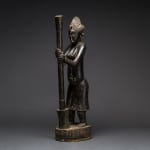Senufo Wooden Sculpture of a Woman Pounding Grain, 20th Century CE
Wood
76.8 x 20.3 cm
30 1/4 x 8 in
30 1/4 x 8 in
PF.4748 (LSO)
Further images
This impressive sculpture of a woman pounding grain using a pestle and mortar was made by the Senufo group of the Ivory Coast area. The figure is traditionally Senufo in...
This impressive sculpture of a woman pounding grain using a pestle and mortar was made by the Senufo group of the Ivory Coast area. The figure is traditionally Senufo in terms of elongated proportions, a long torso and shorter legs, while the downturned, delicately rendered face and detailed coiffure are also characteristic. She is very curvilinear in design, with prominent breasts and protuberant abdomen, reiterating the fertility-linked iconography typical of female Senufo sculptures. The piece is secular in that it does not seem to be linked to any known Senufo religious or ritual tradition, although it may refer to an ancestress or other important person from Senufo history.
Pieces such as this are not as well known as the standard Senufo icon – pombilele, or rhythm pounders – although in representing half of an ancestor couple the intellectual intention is much alike. At the heart of Senufo society is a patriarchal group of elders known as the Poro, which is responsible for many religious and secular functions to do with the running of the tribal group. Smaller-scale magical issues, however, are usually dealt with by diviners or soothsayers (sandoo). Figures representing ancestors and spirits are used both centrally and in individual homes.
The Senufo group, based in the Ivory Coast and Mali area, migrated to their current location from the north during the 15th and 16th centuries AD. Their economy is primarily agricultural and settled. As a result specialist trades have become established, primary among which is the expert carver. These are typically important people, as the Senufo have a long history of using highly decorated ritual and secular objects in many aspects of everyday life. Their extremely high level of skill in woodcarving is primarily turned towards magical-religious art, but secular pieces such as this demonstrate personal vision that makes for a charming piece of African art.
Pieces such as this are not as well known as the standard Senufo icon – pombilele, or rhythm pounders – although in representing half of an ancestor couple the intellectual intention is much alike. At the heart of Senufo society is a patriarchal group of elders known as the Poro, which is responsible for many religious and secular functions to do with the running of the tribal group. Smaller-scale magical issues, however, are usually dealt with by diviners or soothsayers (sandoo). Figures representing ancestors and spirits are used both centrally and in individual homes.
The Senufo group, based in the Ivory Coast and Mali area, migrated to their current location from the north during the 15th and 16th centuries AD. Their economy is primarily agricultural and settled. As a result specialist trades have become established, primary among which is the expert carver. These are typically important people, as the Senufo have a long history of using highly decorated ritual and secular objects in many aspects of everyday life. Their extremely high level of skill in woodcarving is primarily turned towards magical-religious art, but secular pieces such as this demonstrate personal vision that makes for a charming piece of African art.
Literature
V28





